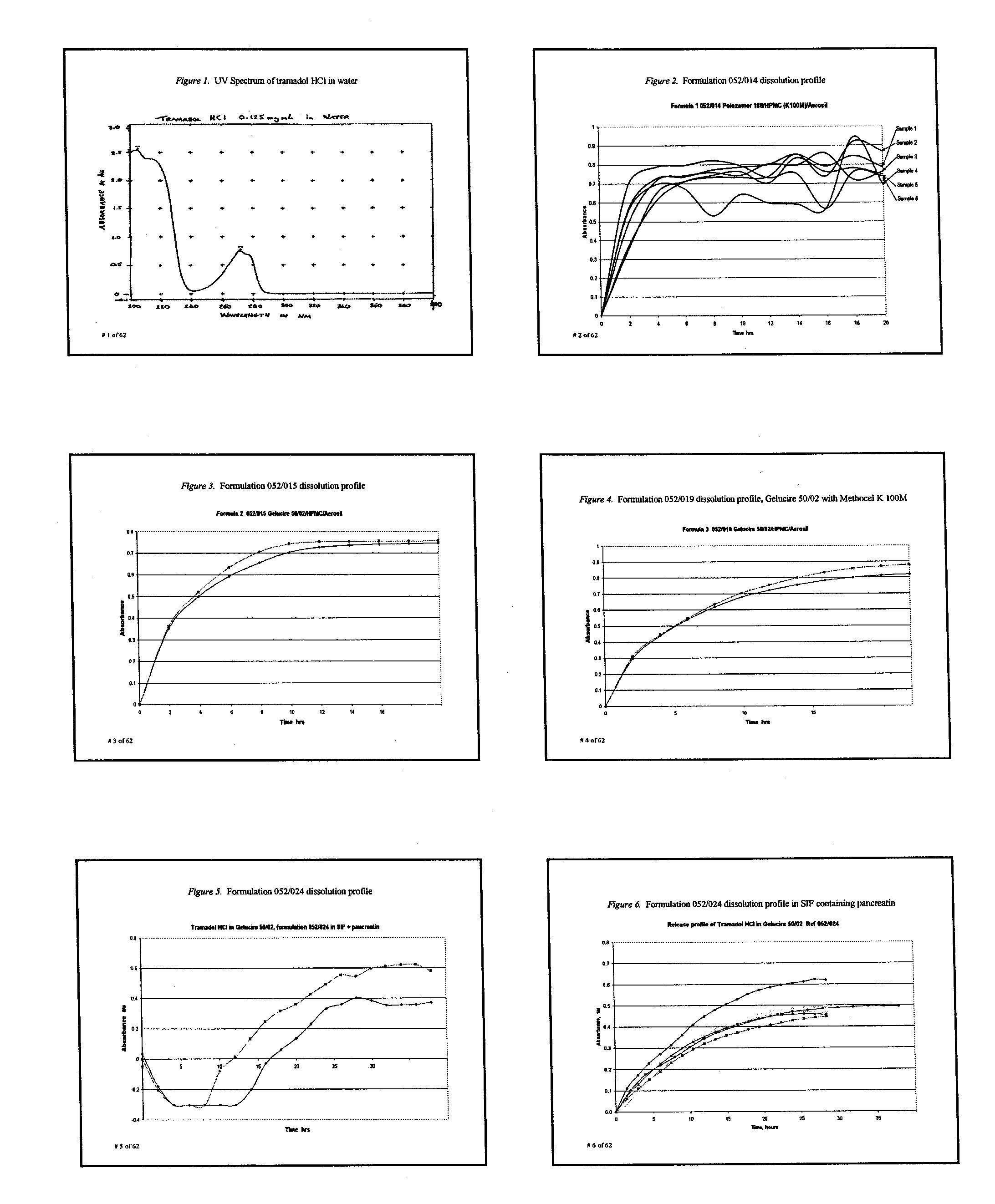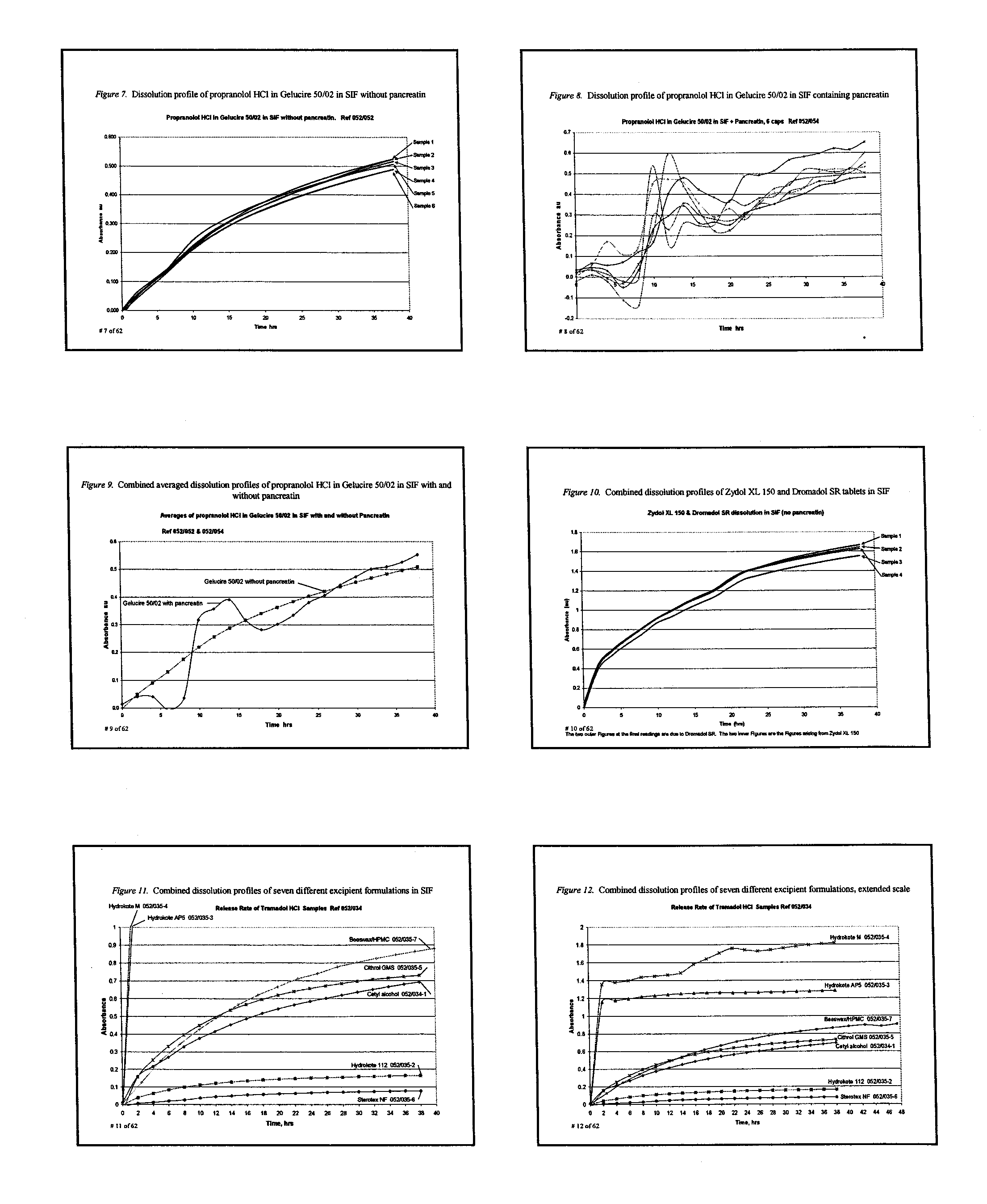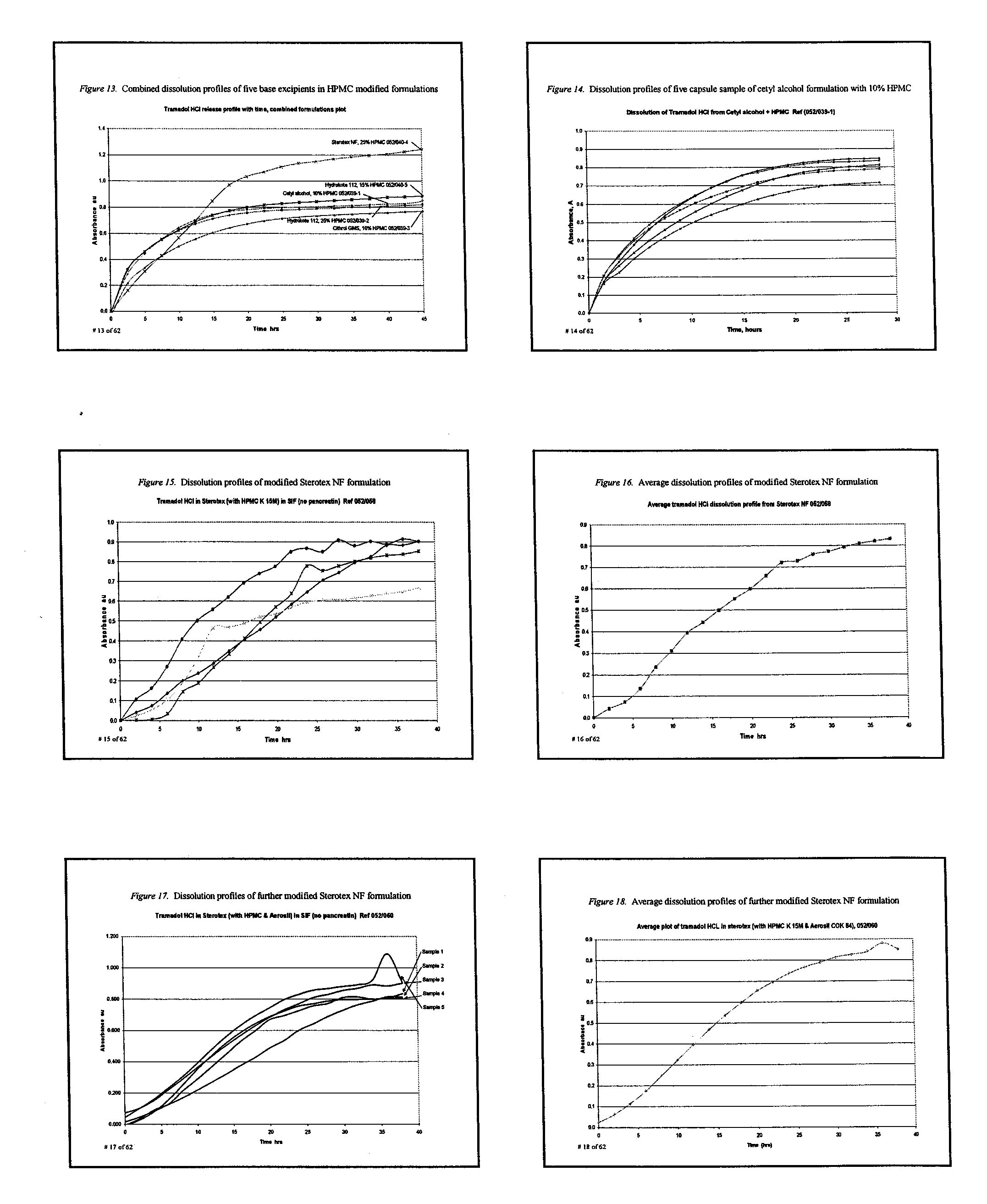Multimodal Abuse Resistant and Extended Release Opioid Formulations
a technology of abuse resistance and opioid formulation, which is applied in the field of abuse resistant multimodal oral and extended release pharmaceutical compositions of opioid agonists, can solve the problems of drug addiction, drug diversion and drug abuse, and poor quality-of-life outcomes, and achieves the effects of improving quality of life, drug diversion and drug abuse, and improving pain control
Active Publication Date: 2010-09-30
RELMADA THERAPEUTICS
View PDF89 Cites 159 Cited by
- Summary
- Abstract
- Description
- Claims
- Application Information
AI Technical Summary
Benefits of technology
[0525]The pharmacologic effects of the pharmaceutical compositions of the present invention can be evaluated using methods well established in the art. The choice of method will depend, among other things, on: (i) the abusable drug and (ii) the therapeutic use to which the abusable drug is applied (i.e., the disease, disorder, or symptom(s) being treated with the abusable drug). Opioid analgesics, while primarily used for the treatment of pain have multiple therapeutic applications. Additionally, certain evaluations may be conducted in healthy subjects, recreational drug users or drug addicts. A wide variety of clinical states and study designs may be used to evaluate the therapeutic effects of intact and tampered dosage forms of the invention. This invention therefore contemplates the use of test methods other than those specifically disclosed herein, including those which may hereafter become known to the art to be capable of performing the necessary functions. Sample sizes in the studies are sufficient to demonstrate the objectives of the testing. A non-limiting list of methods to evaluate the analgesic and other effects of the invention is provided below:
[0526]Male and female patients with acute postsurgical pain following the removal of one or more bony impacted third molars are participants. Within 4 to 6 hours after completion of surgery, patients who are experiencing moderate or severe pain, as measured by a visual analog pain intensity scale (VAS ≧50 mm) and by a categorical pain intensity scale (moderate or severe pain descriptor), and who meet all other inclusion / exclusion criteria are admitted to the study. Patients are randomly assigned to receive the dosage form of the invention given intact or placebo, in some preferred embodiments, and the dosage form of the invention given intact or dosage form of the invention given in tampered form in other embodiments. Both single and multiple (repeated) dose studies may be conducted. Pain intensity (VAS and categorical), pain relief (categorical) and whether pain is half-gone is recorded by the patient under the supervision of the investigator study coordinator at the various time points: Baseline (0 hour—pain intensity only), 15, 30 and 45 minutes, and at 1, 1.5, 2, 3, 4, 5, 6, 7, 8 and 12 hours after administration of study medication, and immediately prior to the first rescue dose. Sedation and nausea may be evaluated using VAS or categorical scales. Time to onset of perceptible and meaningful pain relief is evaluated using the two stopwatch method. Patients record their global evaluation of study medication at the completion of the 8-hour assessment or at the time of first rescue medication use. Efficacy endpoints include Total Pain Relief (TOTPAR), Sum of Pain Intensity Difference (SPID) and Sum of Pain Relief Intensity Difference (SPRID) at various time points, Time to First Rescue, Time Specific Pain Intensity Difference (PID), Time Specific Pain Relief (PR), Peak Pain Intensity Difference (PPID), Peak Pain Relief (PPR), Time to Confirmed Perceptible Pain Relief (stopwatch), Time to Meaningful Pain Relief (stopwatch), Patient Global Evaluation, Time to Change in Categorical PID ≧1, Percent Change in Pain Intensity Score from Baseline, Mean Change in Pain Intensity Score From Baseline, Percent Change in Pain Relief Score from Baseline, Mean Change in Pain Relief Score From Baseline, Percent of Responders, Number of Patients Needed to Treat to Obtain One Patient with ≧50% Response (NNT).Bunionectomy Surgery
[0527]Male or female patients requiring primary unilateral first metatarsal bunionectomy surgery alone or with ipsilateral hammertoe repair (without additional collateral procedures) under regional anesthesia (Mayo block) are participants.
[0528]Patients who experience moderate or severe pain on a categorical scale (moderate or severe descriptor) and on a visual analog pain intensity scale (VAS; ≧50 mm) within 6 hours following completion of bunionectomy surgery are randomly assigned to receive the dosage form of the invention given intact or placebo In some preferred embodiments, and the dosage form of the invention given intact or dosage form of the invention given in tampered form in other embodiments. Both single and multiple (repeated) dose studies may be conducted. Patients are encouraged to wait at least 60 minutes before requesting remedication for pain. At the completion of the single-dose phase (8 hours) or at first request for remedication (whichever is earlier), patients enter into a multiple-dose phase lasting approximately 72 hours. During the multiple dose phase patients receive study medication or placebo at a fixed dose interval (e.g., every 8, 12 or 24 hours). Once the multiple dose phase of the study has begun, patients experiencing pain between scheduled doses of study medication are provided access to supplemental open-label (rescue) analgesia. Patients whose pain cannot be adequately managed on a combination of study medication and rescue medication or who develop unacceptable side effects during the study are discontinued from further study participation and their pain managed conventionally.
[0529]Pain intensity (VAS and categorical), pain relief (categorical) and whether pain is half-gone is recorded by the patient under the supervision of the investigator study coordinator at representative time points, e.g., Baseline (pain intensity only), 15, 30 and 45 minutes and 1, 1.5, 2, 3, 4, 5, 6, 7 and 8 hours after administration of study medication and immediately prior to the first remedication. Sedation and nausea may be evaluated using VAS or categorical scales. Time to onset of perceptible and meaningful pain relief is evaluated using the double-stopwatch method. Patients complete a global evaluation of study medication at the completion of the 8-hour assessment or just prior to the first remedication. Following completion of the single-dose phase (8 hours or just prior to first remedication, if ≦8 hours), patients begin the multiple dose phase of the study. During the multiple dose phase, patients record their overall pain intensity since the previous scheduled dose, their current pain intensity and a patient global, immediately prior to each scheduled dose of study medication and at early termination.
[0530]Measures of efficacy in the single-dose phase include Sum of Pain Intensity Difference (SPID), Total Pain Relief (TOTPAR), Sum of Pain Relief Intensity Difference (SPRID), Time to First Remedication, Time Specific Pain Intensity Difference (PID), Time Specific Pain Relief (PR), Peak Pain Intensity Difference (PPID), Peak Pain Relief (PPR), Time to Confirmed Perceptible Pain Relief (stopwatch), Time to Meaningful Pain Relief (stopwatch), Patient Global Evaluation, Time to Change in Categorical PID ≧1, Percent Change in Pain Intensity Score from Baseline, Mean Change in Pain Intensity Score From Baseline, Percent Change in Pain Relief Score from Baseline, Mean Change in Pain Relief Score From Baseline, Percent of Responders, Number of Patients Needed to Treat to Obtain One Patient with ≧50% Response (NNT).
Problems solved by technology
Ferrell et al (Oncol Nur Forum 1989; 4:521-6) compared 12-hourly controlled release morphine and short-acting analgesics in cancer pain and demonstrated that compliance increased as the required dosing frequency decreased, and noncompliance resulted in suboptimal pain control and poor quality-of-life outcomes.
An important drawback with the use of opioids is the risk of drug addiction, drug diversion and drug abuse.
This in turn has led to concerns about the increased non-medical use of opioids through both licit and illicit channels.
For instance, unsuspecting clinicians may prescribe opioids for pain to individuals with an addiction disorder or individuals with pain who divert a portion of their prescribed dose to other individuals.
There have also been documented cases of inappropriate prescribing or dispensing of opioids by physicians and pharmacists, with its eventual diversion into the non-medical marketplace.
However, the incidence and severity of side effects limits the use of morphine in some patients (Hagen and Babul, Cancer 1997; 79:1428-37).
The 12 or 24-hour supply of opioid contained in one tablet or capsule, instead of 4 to 6 tablets or capsules means that there is a greater risk that such formulations may be highly sought by drug addicts and recreational drug users alike, for non-medical use.
Intentional or inadvertent tampering from extended release formulations will rapidly deliver a massive dose and produce profound a variety of serious and life threatening side effects, including respiratory depression and failure, sedation, cardiovascular collapse, coma and death.
Scheduling of opioid drugs has also had the unintentional side-effect of causing physicians, fearful of being accused of permitting “opioid overuse”, to prescribe suboptimal doses of opioids to patients in need of them, and to prescribe less effective drugs to patients that are not similarly scheduled.
Among the reasons frequently cited as causative of undertreatment are: (1) the failure to prescribe enough drug at the right dosage interval to reach a steady-state threshold commensurate with the pain relief needed; (2) failure of patients to comply with a given dosage regimen; and (3) the reluctance of many physicians to prescribe analgesics categorized as controlled drugs based on often unfounded concerns of future addiction and fear of regulatory sanctions.
A number of reported cases of opioid toxicity are a result of inadvertent or unintentional medical use of opioids.
However, in the case of extended release opioid formulations, crushing the oral solid dosage form destroys the controlled-release mechanism and results in a rapid surge of drug into the bloodstream, with the entire 12 or 24-hour drug supply released immediately with toxic effects.
Similarly, abuse deterrent pharmaceutical compositions containing aversive substances can cause serious harm to subjects if injected intravenously and the long terms safety of small amounts of such aversive substances which would be inevitably released in the gastrointestinal tract is unknown.
In 2005, a serious new clinical problem arose with the therapeutic use of extended release opioids, particularly extended release formulations in capsule dosage forms, when co-ingested with alcohol.
The problem was discovered with a once-a-day extended release formulation of the opioid hydromorphone HCL (Palladone® capsules).
In 2005, Palladone® capsules were withdrawn from the market in both countries due to dose-dumping when co-ingested with alcohol.
In requesting the withdrawal of Palladone® capsules, FDA noted that the manufacturer of “Palladone® provided FDA data that showed that drinking alcohol while taking Palladone® capsules may cause rapid release of hydromorphone, leading to high drug levels in the body, with potentially fatal effects.
The Agency has concluded that the overall risk versus benefit profile of Palladone® is unfavorable due to a potentially fatal interaction with alcohol.
Pharmacokinetic data indicate that the co-ingestion of Palladone® and alcohol results in dangerous increases in the peak plasma concentrations of hydromorphone.
FDA has since noted that a number of other capsule formulations of extended release opioids may be similarly vulnerable to dose dumping when co-ingested with alcohol.
While the relevance of in vitro lab tests regarding Avinza® to the clinical setting remains to be determined, this acceleration of release may correlate with in vivo rapid release of the total morphine dose, which could result in the absorption of a potentially fatal dose of morphine.
Additionally, extended release formulations can make otherwise non-viable pharmaceutical agents (e.g., due to an exceedingly short duration of effect) into viable formulations with clinical and commercial potential.
Toxicity from opioids can result from unintentional or intentional tampering of the dosage form.
However, in the case of extended release dosage forms of opioids, crushing the oral solid dosage form destroys the controlled-release mechanism and results in a rapid surge of drug into the bloodstream, with the entire 8, 12 or 24-hour drug supply released immediately with toxic effects, or pleasurable effects in the case of a drug abuser.
To date, no extended release formulations of opioids with abuse deterrent technology of any kind have been submitted for Marketing Application (New Drug Application) or been commercialized anywhere in the world.
Indeed if prior drug development history is any guide, most such strategies are unlikely to be developed or commercialized and the optimal formulation(s) will likely be apparent only through postmarketing surveillance of several formulations with competing technologies.
With the ready access to information from their well knit network and more recently, from websites on how to optimally extract the active agent from pharmaceutical dosage forms and maximize euphoriant effects, the development of abuse deterrent formulations has become a major pharmaceutical, clinical, regulatory and law enforcement challenge.
While the scheduling of opioids as “controlled drugs” has reduced abuse of the drugs, it has not been entirely successful.
In other cases, certain health professionals, unfortunately, have been found to be culprits in the non-approved distribution of opioid drugs.
Scheduling of opioids has also had the unintentional side-effect of causing physicians, fearful of being accused of permitting or even promoting drug abuse and drug overuse, to prescribe suboptimal doses of opioids to patients in need of them, and to prescribe less effective drugs to patients that are not similarly scheduled.
An additional issue with extended release forms of drugs, including opioids is the interaction of the drug, even in an untampered form, when consumed with alcohol.
Under such conditions, a number of drugs have demonstrated an in vitro and in vivo propensity for significant dose dumping when they are co-ingested for medical purposes at prescribed doses with alcohol, increasing the potential for drug toxicity and further exacerbating the intensity of the (abusable) drug-alcohol pharmacodynamic interaction.
The issue of food effects on oral bioavailability has particular importance with oral extended release products, due to the possibility of “dose dumping” where the is potential that a portion or a substantial portion of the dose intended to be released gradually over time (e.g., over 8, 12 or 24 hours) may be released instantaneously or rapidly, such that the peak plasma concentration of the drug (peak exposure) will be substantially increased, resulting in toxicity and the duration of effect will be significantly reduced, potentially resulting in reduced duration of therapeutic effect.
Method used
the structure of the environmentally friendly knitted fabric provided by the present invention; figure 2 Flow chart of the yarn wrapping machine for environmentally friendly knitted fabrics and storage devices; image 3 Is the parameter map of the yarn covering machine
View moreImage
Smart Image Click on the blue labels to locate them in the text.
Smart ImageViewing Examples
Examples
Experimental program
Comparison scheme
Effect test
example 1
[0560]
IngredientsQuantity (mg) / DoseSterotex ® NF200Fractionated coconut oil70Methocel ® K 15M81Aerosil ® COK 844Oxycodone20Capsule fill weight375
example 2
[0561]
IngredientsQuantity (mg) / DoseSterotex ® NF135Fractionated coconut oil50Methocel ® K 15M60Aerosil ® COK 843Levorphanol2Capsule fill weight250
example 3
[0562]
IngredientsQuantity (mg) / DoseSterotex ® NF170Fractionated coconut oil100Methocel ® K 15M70Aerosil ® COK 844.5Hydromorphone5.5mgCapsule fill weight350
the structure of the environmentally friendly knitted fabric provided by the present invention; figure 2 Flow chart of the yarn wrapping machine for environmentally friendly knitted fabrics and storage devices; image 3 Is the parameter map of the yarn covering machine
Login to View More PUM
| Property | Measurement | Unit |
|---|---|---|
| melting point | aaaaa | aaaaa |
| melting point | aaaaa | aaaaa |
| time | aaaaa | aaaaa |
Login to View More
Abstract
The present invention is in the field of oral, abuse resistant pharmaceutical compositions of opioid agonists, extended release pharmaceutical compositions of opioid agonists and extended release abuse resistant pharmaceutical compositions of opioid agonists and the use thereof. The present invention is also directed to extended release pharmaceutical compositions and the use thereof for preventing or minimizing the risk of abuse and / or toxicity from either intentional or unintentional tampering. The present invention is further directed at a method of preventing or minimizing the risk of abuse and / or toxicity from either intentional or unintentional tampering.
Description
FIELD OF THE INVENTION[0001]The present invention is in the field of multimodal oral, abuse resistant pharmaceutical compositions of opioid agonists, extended release pharmaceutical compositions of opioid agonists, extended release abuse resistant pharmaceutical compositions of opioid agonists and the use thereof.BACKGROUND OF THE INVENTION[0002]Although the abuse of opioids has been documented over many centuries, it is largely in the last century that we have been confronted by the abuse of pharmaceutical grade opioids in the form of pharmaceutical dosage forms intended for therapeutic uses. The abuse of opioids is either due to iatrogenic addiction or willful abuse of the products outside their intended use or method of use by drug abusers and recreational drug users.[0003]Currently, medical practitioners may choose from several well-accepted classes of pharmaceutical agents in their attempts to alleviate and prevent pain. Nonlimiting examples of agents used include nonsteroidal ...
Claims
the structure of the environmentally friendly knitted fabric provided by the present invention; figure 2 Flow chart of the yarn wrapping machine for environmentally friendly knitted fabrics and storage devices; image 3 Is the parameter map of the yarn covering machine
Login to View More Application Information
Patent Timeline
 Login to View More
Login to View More Patent Type & Authority Applications(United States)
IPC IPC(8): A61K31/485A61K31/454A61K31/451A61K31/473A61K31/4184A61K31/5377A61K31/135A61K31/167A61K31/24A61K31/381A61K31/4453A61K31/55A61K31/439A61K31/497A61K31/706A61K31/36A61K38/10A61K31/4468A61K31/5375A61K31/4545A61K31/40A61K31/4535A61K31/137A61P25/04
CPCA61K9/485A61K31/44A61K9/4866A61K9/4858A61P25/04
Inventor BABUL, NAJIB
Owner RELMADA THERAPEUTICS
Features
- R&D
- Intellectual Property
- Life Sciences
- Materials
- Tech Scout
Why Patsnap Eureka
- Unparalleled Data Quality
- Higher Quality Content
- 60% Fewer Hallucinations
Social media
Patsnap Eureka Blog
Learn More Browse by: Latest US Patents, China's latest patents, Technical Efficacy Thesaurus, Application Domain, Technology Topic, Popular Technical Reports.
© 2025 PatSnap. All rights reserved.Legal|Privacy policy|Modern Slavery Act Transparency Statement|Sitemap|About US| Contact US: help@patsnap.com



